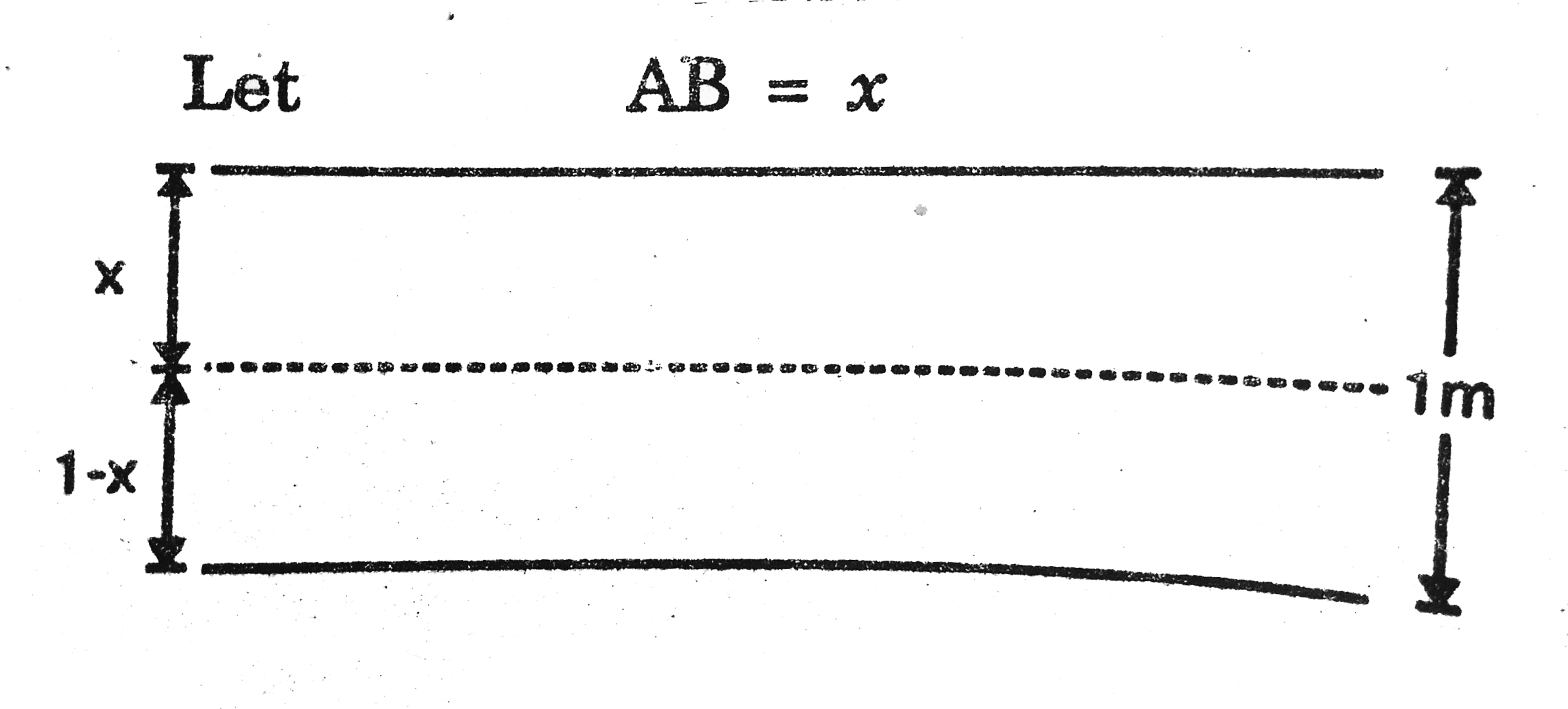Consider the situation of the previous problem. Assume that the temperature of the water at the botton of the lake remains constant at 4∘C as the ice forms on the surface (the heat required to maintain the temperature of the bottom layer may come from the bed of the lake). The depth of the lake is 1.0m. Show that the thickness of the ice formed attains a steady state maximum value. Find this value. The thermal conductivity of water =0.50Wm−1.∘C−1 . Take other relevent data form the previous problelm.
The correct Answer is:C
Let B be the maximum level up to which ice is formed. Hence the heat conducted at that point form both the level is same.
i.e,Qicet=Qwatert
implies (K_(ice)xxAxx10)/x=(K_(water )xxAxx10)/(1-x)<br>⇒1.7×10x=5×10−1×41−x
implies(17)/x=(2)/(1-x)<br>implies 17-17x=2x<br>implies19x=17<br>implies x=(17)(19)=0.894m=89 cm.

Topper's Solved these Questions
Similar Questions
A centigrade and a Fahrenheit thermometer are dipped in boiling water. The water temperature is lowered until the Fahrenheit thermometer registered at 140°F. What is the fall in temperature as registered by the centigrade thermometer ?
View SolutionThe steam point and the ice point of a mercury thermometer are marked as 80∘C and 20∘C. What will be the temperature in centigrade mercury scale when this thermometer reads 32∘C?
View SolutionFind the dimensions of
a. linear momentum
b. frequency and
c. pressure
View SolutionConsider the situation of the previous problem. Assume that the temperature of the water at the botton of the lake remains contant at 4^(@)C as the ice forms on the surface (the heat required to maintain the temperature of the bottom layer may come from the bed of the lake). The depth of the lake is 1.0m. Show that the thickness of the ice formed attains a steady state mamimum value. Find this value. The thermal conductivity of water =0.50Wm ^(-1) ^(@)C^(-1) . Take other relevent data form the previous problelm.
View SolutionTemperature of water at the surface of lake is −20∘C. Then temperature of water just below the lower surface of ice layer is
View SolutionIn a 10 m deep lake, the bottom is at a constant temperature of 4^(@)C . The air temperature is constant at - 4^(@)C. K_(ice) = 3 K_(omega) . Neglecting the expansion of water on freezing, the maximum thickness of ice will be
View SolutionIn an 20 m deep lake, the bottom is at a constant temperature of 4∘C. The air temperature is constant at −10∘C. The thermal conductivity of ice in 4 times that water. Neglecting the expansion of water on freezing, the maximum thickness of ice will be
View SolutionTemperature of water at the surface of lake is – 20°C. Then temperature of water just below the lower surface of ice layer is
View SolutionIn winters ice forms on the surface of a lake. Due to abnormal expansion of water the temperature of the water at the bottom of the lake remains constant at 4∘C and we assume that the amount of heat required to maintain this temperamre of the bottom layer of water may come from the bed of the lake. If surrounding temperature is - 10∘C Prove that ice formed from the surface of the lake attains a maximum thickness. Find the maximum depth from surface upto which ice is formed if the depth of lake is I m. Given that thermal conductivity of ice is 0.5W/m∘C.
View SolutionIce is formed on the top surface of a lake. Temperature of air above ice is −15∘C, (i) What is the temperature of the water layer just below ice? (ii) Find the maximum possible temperature at the bottom of the lake.
View SolutionThe top of a lake is frozen. Air just above the ice layer is at -15^(@)C . What is the temperature of the water layer just below ice? Comment on the maximum possible temperature at the bottom of the lake.
View SolutionIf the surface temperature of the water in the lake is 2 ° C, then the temperature of the water at the bottom of the lake will be
View SolutionWater temperature on the surface of a lake 20^(@)C is. Then the water temperature under the frozen ice in the lake
View SolutionAn air bubble comes from the bottom to the surface of a lake of depth 2.5 m. The surface temperature of the lake is 40^(@)C . The diameter of the bubble at the bottom and at the surface are 3.6 mm and 4 mm respectively. Find the temperature of the lake at the bottom.
View SolutionAn air bubble comes from the bottom to the surface of a lake of depth 2.5 m. The surface temperature of the lake is 40°C. The diameter of the bubble at the bottom and at the surface are 3.6 mm and 4 mm respectively. Find the temperature of the lake at the bottom.
View SolutionIn an 20 m deep lake, the bottom is at a constant temperature of 4∘C. The air temperature is constant at −10∘C. The thermal conductivity of ice in 4 times that water. Neglecting the expansion of water on freezing, the maximum thickness of ice will be
View Solution
